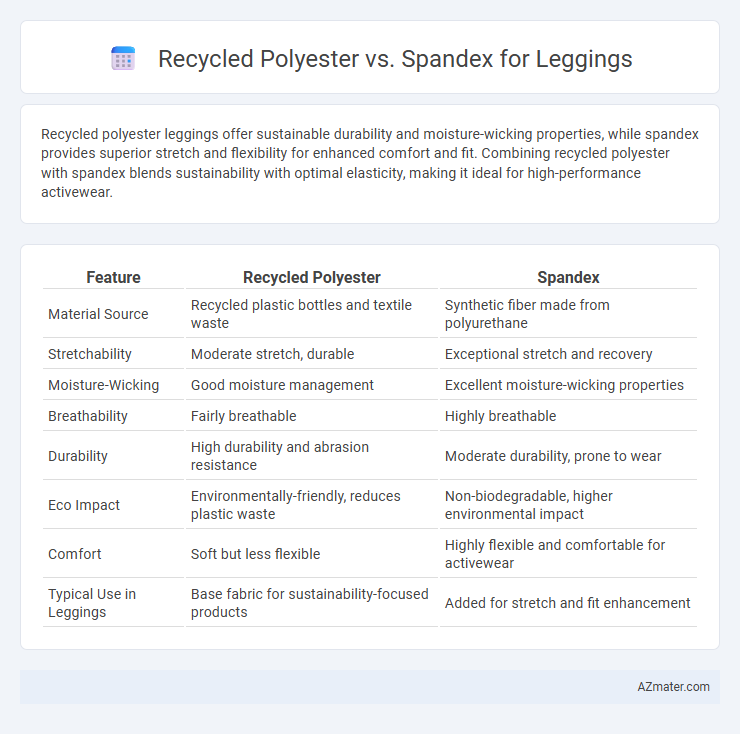Recycled polyester leggings offer sustainable durability and moisture-wicking properties, while spandex provides superior stretch and flexibility for enhanced comfort and fit. Combining recycled polyester with spandex blends sustainability with optimal elasticity, making it ideal for high-performance activewear.
Table of Comparison
| Feature | Recycled Polyester | Spandex |
|---|---|---|
| Material Source | Recycled plastic bottles and textile waste | Synthetic fiber made from polyurethane |
| Stretchability | Moderate stretch, durable | Exceptional stretch and recovery |
| Moisture-Wicking | Good moisture management | Excellent moisture-wicking properties |
| Breathability | Fairly breathable | Highly breathable |
| Durability | High durability and abrasion resistance | Moderate durability, prone to wear |
| Eco Impact | Environmentally-friendly, reduces plastic waste | Non-biodegradable, higher environmental impact |
| Comfort | Soft but less flexible | Highly flexible and comfortable for activewear |
| Typical Use in Leggings | Base fabric for sustainability-focused products | Added for stretch and fit enhancement |
Introduction to Recycled Polyester and Spandex in Leggings
Recycled polyester in leggings offers a sustainable alternative by utilizing post-consumer plastic bottles, reducing environmental impact while maintaining durability and moisture-wicking properties. Spandex, known for its exceptional elasticity and shape retention, provides leggings with flexibility and comfort crucial for activewear. Combining recycled polyester and spandex results in eco-friendly leggings that support movement with a soft, breathable fit.
Sustainability: Recycled Polyester vs Spandex
Recycled polyester offers a sustainable alternative to virgin polyester by reducing plastic waste and lowering carbon emissions in legging production. Spandex, while providing essential stretch and comfort, is typically derived from non-renewable fossil fuels and presents challenges in biodegradability, impacting environmental sustainability. Choosing recycled polyester leggings supports circular fashion initiatives and minimizes ecological footprints compared to traditional spandex-based materials.
Comfort and Feel: Fabric Comparison
Recycled polyester leggings offer a smooth, lightweight feel with excellent moisture-wicking properties, enhancing breathability and comfort during extended wear. Spandex provides superior elasticity and stretch, allowing leggings to move seamlessly with the body while maintaining shape and offering a soft, second-skin sensation. Combining recycled polyester with spandex creates a fabric blend that balances durability, stretch, and softness, ideal for comfortable, performance-focused leggings.
Stretch and Flexibility: Which Performs Better?
Recycled polyester offers excellent durability and moisture-wicking properties but typically provides less stretch and flexibility compared to spandex. Spandex excels in elasticity, often delivering up to 600% stretch, making it the preferred choice for leggings requiring superior flexibility and shape retention. Blends combining recycled polyester with spandex optimize sustainable performance while ensuring maximum comfort and unrestricted movement.
Breathability and Moisture Management
Recycled polyester offers superior breathability and moisture-wicking properties compared to Spandex, making it ideal for leggings designed for high-intensity activities. The fabric efficiently draws sweat away from the skin and dries quickly, enhancing comfort and reducing the risk of irritation. Spandex, while providing excellent stretch and flexibility, is less effective at moisture management and breathability, often trapping heat and moisture during prolonged wear.
Durability and Longevity in Activewear
Recycled polyester offers superior durability and longevity for leggings due to its strong fiber composition, resisting pilling and maintaining shape through repeated wash cycles. Spandex, while essential for stretch and flexibility, tends to lose elasticity over time, especially with frequent wear and exposure to sweat and heat. Combining recycled polyester with spandex blends maximizes performance by balancing robust durability with comfortable stretch in activewear.
Environmental Impact of Recycled Polyester vs Spandex
Recycled polyester significantly reduces environmental impact by diverting plastic waste from landfills and lowering carbon emissions compared to virgin polyester production, while spandex, being a synthetic polyurethane material, poses challenges in biodegradability and recycling. The production of recycled polyester consumes less energy and water, contributing to a smaller ecological footprint in legging manufacturing. Spandex fibers, often blended with polyester, complicate recycling processes and increase microplastic pollution during washing.
Cost Comparison for Legging Production
Recycled polyester generally offers a lower cost than spandex in legging production due to its sustainable sourcing and widespread availability, making it an economical choice for mass manufacturing. Spandex, while providing superior stretch and flexibility, tends to have higher raw material prices and processing costs, increasing overall production expenditure. Manufacturers often balance cost and performance by blending recycled polyester with a smaller percentage of spandex to optimize legging durability and comfort while controlling production expenses.
Care and Maintenance Differences
Recycled polyester leggings require gentle machine washing in cold water and air drying to preserve their shape and prevent microplastic shedding, while spandex leggings demand careful hand washing or delicate machine cycles with mild detergent to maintain elasticity and avoid fabric breakdown. Polyester's hydrophobic nature repels moisture quickly, making it easier to dry and less prone to odor retention compared to spandex, which absorbs sweat and may need more frequent washing. Overstretching spandex reduces its lifespan faster than recycled polyester, which maintains durability with minimal shrinkage under standard care conditions.
Which Material is Best for Leggings?
Recycled polyester offers durability, moisture-wicking properties, and eco-friendly benefits, making it ideal for leggings used in high-intensity workouts. Spandex provides superior stretch and flexibility, ensuring a comfortable, form-fitting silhouette essential for activities like yoga and dance. The best material depends on your priority: choose recycled polyester for sustainability and performance, or spandex for maximum elasticity and shape retention.

Infographic: Recycled polyester vs Spandex for Legging
 azmater.com
azmater.com